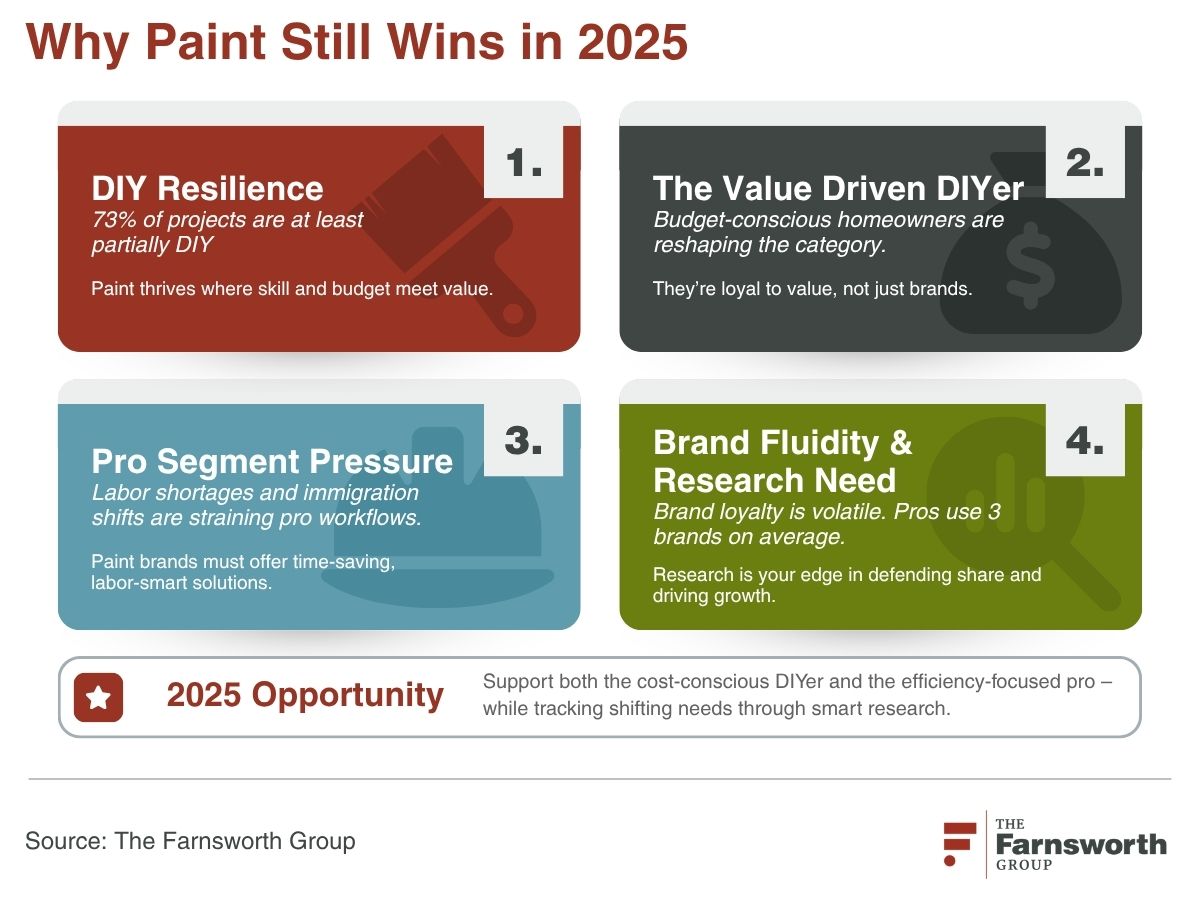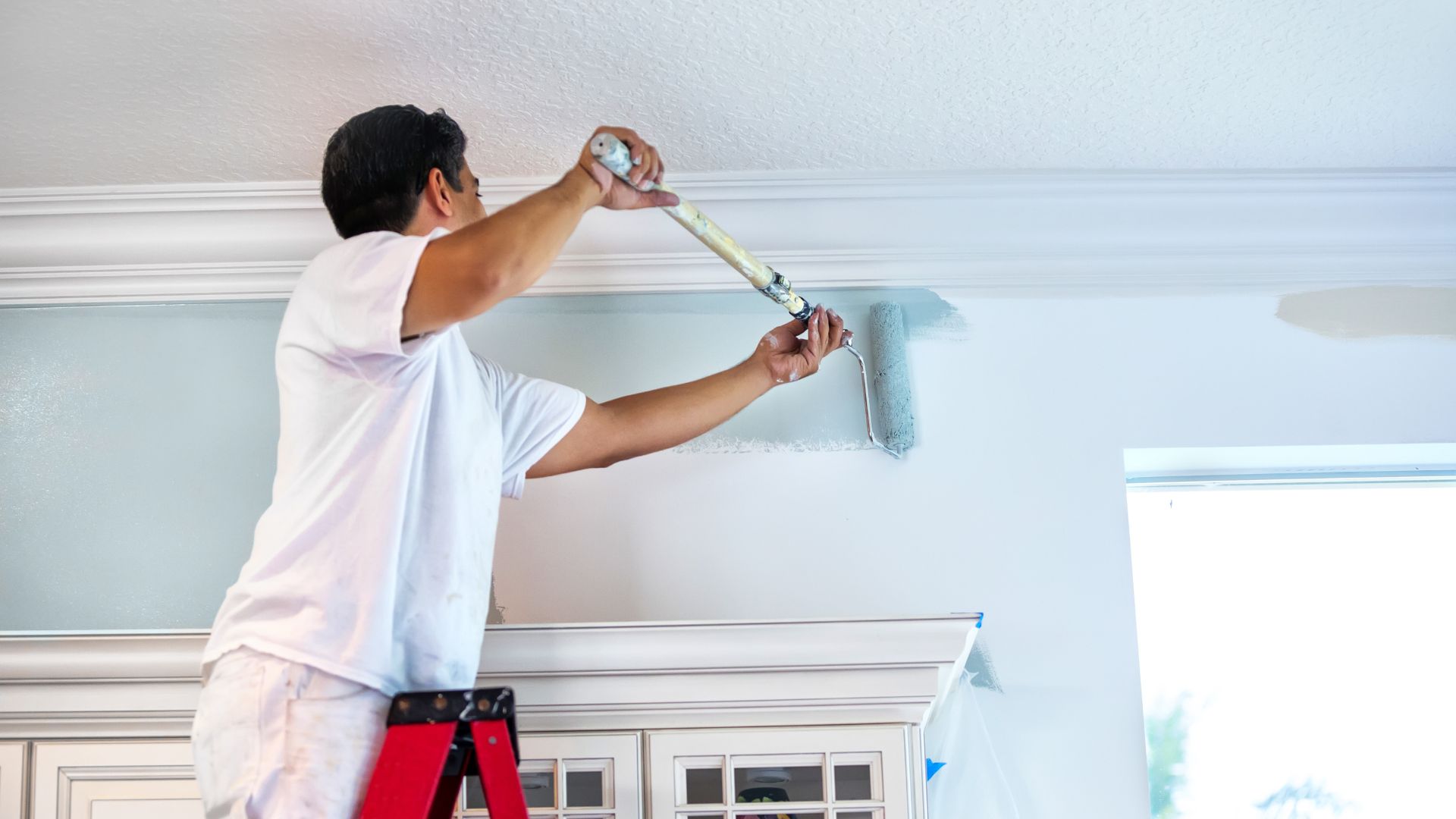Despite economic fluctuations and labor headwinds, the paint and paint supplies category remains one of the most resilient in home improvement. The reasons are layered (DIY dominance, shifting homeowner budgets, pro workforce realities) but the opportunity for brands is clear: stay close to your customer and don’t take category loyalty for granted.

DIY Paint Projects: A Cornerstone in a Cautious Economy
Findings from our Home Improvement Quarterly Tracker, conducted in partnership with The Home Improvement Research Institute, reveal that DIY continues to dominate homeowner project execution, with nearly three-quarters of home improvement projects being completed at least partially DIY. This trend is particularly strong for paint-related projects, which offer homeowners high perceived value, manageable complexity, and visible transformation at a relatively low cost.
While overall project activity has dipped for the third consecutive quarter, painting has held firm. nearly half of homeowners purchased paint or paint supplies in the past 90 days. It’s the type of project homeowners can still tackle when they’re not willing to spend $10K but still want to make a visual impact. And for marketers and researchers alike, that stability is gold.
Budget-Conscious Segments Are Reshaping the Market
Homeowners with financial constraints are becoming a more visible and influential segment in the home improvement landscape. While our latest Industry Drivers Report shows high-income households still account for the majority share of home improvement spend (and growing), recent shifts in project scope, execution, and spending levels point to the rise of a budget-conscious DIY cohort that’s increasingly active in categories like paint, where perceived value is high and barriers to entry are low.
73% of homeowners who delayed or canceled projects did so due to budget concerns, and many are opting for partial or full DIY execution as a cost-saving strategy. This emerging group is not just making different choices - they’re evaluating brands differently and are more open to switching if it means better value or availability.
For paint brands, this means building strategies that balance the expectations of both the value-driven DIYer and the high-spend, brand-conscious customer. It’s not either-or, it’s both. Understanding the motivations, triggers, and media habits of each segment will be essential to capturing full-category potential.
The Pro Segment: Skilled Labor Tightens, Immigration Impacts Loom
For painting pros, the story is more nuanced. On one hand, the category benefits from stable demand and recurring project needs. On the other, the labor model is under significant pressure. Over one in four labor workers in construction are immigrants (disproportionately moreso for painting crews), and up to half of immigrant labor in some trades are undocumented. This creates fragility in the labor supply and may push more demand toward the DIY side, or toward larger pro outfits who can better absorb compliance risk and wage inflation.
For paint brands, this means rethinking how you support your professional customer base. Brands that can demonstrate how their products address labor issues (such as reducing time on site, simplifying prep and cleanup, or minimizing callbacks) will gain favor. Equally important is aligning messaging and support with the realities of a workforce under pressure, whether that's through targeted training, bilingual resources, or tailored loyalty incentives for larger crews managing variable labor.
Brand Health and U&A Research: Don’t Cut What You Can’t Afford to Lose
In a category where brand loyalty is fluid and driven by availability and price, understanding your position in the mind of the buyer is more critical than ever. Research from our Paint and Supplies Report shows that on average, pros use three different brands of paint annually, and nearly half agree there's a major difference in quality across brands. For marketers, this means that brand performance is not just a perception metric. It directly ties to usage and share.
Brand health tracking and attitudinal/behavioral research provide the diagnostics brands need to defend market share, optimize channel strategy, and differentiate based on what truly drives preference.
What This Means for Paint Brands in 2025
The outlook for the paint category in 2025, and 2026, is cautiously optimistic:
- DIYers aren’t going away. In fact, younger cohorts (Gen Z and Millennials) are driving growth in first-time DIY paint projects, often discovered via YouTube, social media, or in-aisle interactions.
- Big box dominance continues. Brands need to maintain availability in key retailers while improving digital shelf presence to support omnichannel buying journeys.
- Economic uncertainty = opportunity. In times of financial pullback, paint often becomes the go-to refresh strategy. Brands that maintain visibility and connection will outperform.
- Brands that invest in understanding audiences across the full spectrum of spend will be best positioned to grow. In times of shifting preferences and evolving budgets, custom research like brand health tracking and usage & attitudes studies provide clarity on where and how to invest, message, and differentiate.
At The Farnsworth Group, we help paint brands translate market complexity into confident action. Whether you’re measuring brand equity, exploring pricing strategy, or targeting evolving segments of DIYers and pros, our custom research solutions are built for your category realities.
Written By Karen Barnes

Through her expertise in brand consulting, market research design, and advanced analytics, Karen has been helping answer critical business questions for the past 15 years. She has had the privilege of working with many of the top global insights organizations and applying best practices across a myriad of clients in CPG, technology, finance, healthcare, and of course home improvement, including developers, building products manufacturers, and retailers.
An Iowa native, Karen was upgrading from riding mowers to full combines at the annual John Deere employee fair by age 7. Now in Denver, she fills her off hours hiking the Rocky Mountains, uncovering the best local food & drink spots, and traveling as much of the world as humanly possible with her fiancé, Adam.
Meet the rest of The Farnsworth Group team >>



